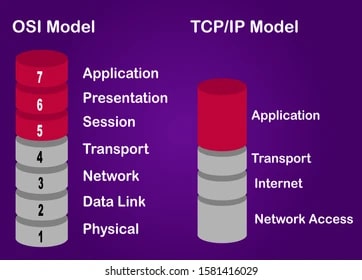TCP/IP and the OSI Model: Understanding the Relationship

If you’ve ever used the internet, you’ve likely encountered the terms TCP/IP and OSI model. While these concepts may seem complex and technical, they are essential to understanding how data is transmitted across networks. In this article, we’ll explain the relationship between TCP/IP and the OSI model, and how they work together to ensure reliable communication.
What is TCP/IP?
TCP/IP is a set of protocols that govern how data is transmitted over the internet. The TCP/IP protocol suite consists of four layers: the application layer, transport layer, network layer, and data link layer. Each layer is responsible for specific tasks related to data transmission.
The application layer is the top layer of the TCP/IP protocol stack. It is responsible for handling high-level protocols such as HTTP, SMTP, and FTP. These protocols define how data is formatted and transmitted between applications.
The transport layer is responsible for managing end-to-end communication between applications. It ensures that data is transmitted reliably and efficiently by providing error checking and flow control.
The network layer is responsible for routing data across networks. It determines the best path for data to take from the source to the destination by using IP addresses.
The data link layer is responsible for transmitting data over a physical connection, such as a network cable. It handles tasks such as error correction, flow control, and data framing.
What is the OSI model?
The OSI (Open Systems Interconnection) model is a conceptual framework that describes how data is transmitted across networks. It consists of seven layers, each of which is responsible for specific tasks related to data transmission.
The seven layers of the OSI model are:
- The physical layer: This layer is responsible for transmitting raw data bits over a physical medium, such as a cable.
- The data link layer: This layer is responsible for transmitting data frames over a physical connection. It provides error checking and flow control.
- The network layer: This layer is responsible for routing data across networks. It determines the best path for data to take from the source to the destination by using IP addresses.
- The transport layer: This layer is responsible for managing end-to-end communication between applications. It ensures that data is transmitted reliably and efficiently by providing error checking and flow control.
- The session layer: This layer is responsible for establishing, maintaining, and terminating sessions between applications.
- The presentation layer: This layer is responsible for translating data between different formats, such as ASCII and EBCDIC.
- The application layer: This layer is responsible for handling high-level protocols such as HTTP, SMTP, and FTP. These protocols define how data is formatted and transmitted between applications.
What is the relationship between TCP/IP and the OSI model?
The TCP/IP protocol suite and the OSI model are both frameworks for understanding how data is transmitted across networks. However, they are not the same thing. The TCP/IP protocol suite is a set of protocols that govern how data is transmitted over the internet, while the OSI model is a conceptual framework that describes how data is transmitted across networks.
Despite their differences, there is a relationship between TCP/IP and the OSI model. The TCP/IP protocol suite can be mapped to the OSI model as follows:
- The application layer of the TCP/IP protocol suite maps to the application, presentation, and session layers of the OSI model.
- The transport layer of the TCP/IP protocol suite maps to the transport layer of the OSI model.
- The network layer of the TCP/IP protocol suite maps to the network layer of the OSI model.
- The data link layer of the TCP/IP protocol suite maps to the data link layer of the OSI model.
- The physical layer of the OSI model is not explicitly defined in the TCP/IP protocol suite, as it deals with the physical transmission of data, which is outside the scope of the TCP/IP
By mapping the TCP/IP protocol suite to the OSI model, we can better understand the relationship between the two frameworks. For example, we can see that the transport layer of TCP/IP is responsible for the same tasks as the transport layer of the OSI model. Both layers provide error checking and flow control to ensure reliable transmission of data.
Similarly, the network layer of TCP/IP and the network layer of the OSI model are responsible for routing data across networks. Both layers use IP addresses to determine the best path for data to take from the source to the destination.
The application layer of TCP/IP and the application, presentation, and session layers of the OSI model are responsible for high-level protocols that define how data is formatted and transmitted between applications.
While the TCP/IP protocol suite and the OSI model are separate frameworks, they are both important for understanding how data is transmitted across networks. By understanding the relationship between these frameworks, we can better understand the underlying principles that govern how the internet works.
Conclusion
TCP/IP and the OSI model are essential frameworks for understanding how data is transmitted across networks. While they have different structures and terminology, they are both focused on ensuring reliable communication between applications. By mapping the TCP/IP protocol suite to the OSI model, we can better understand how the different layers of these frameworks work together to enable communication across the internet.
Whether you’re a network administrator, software developer, or just a curious user, understanding TCP/IP and the OSI model is essential for understanding how the internet works. By delving deeper into these concepts, you can gain a better understanding of the technologies that power our connected world.





Responses